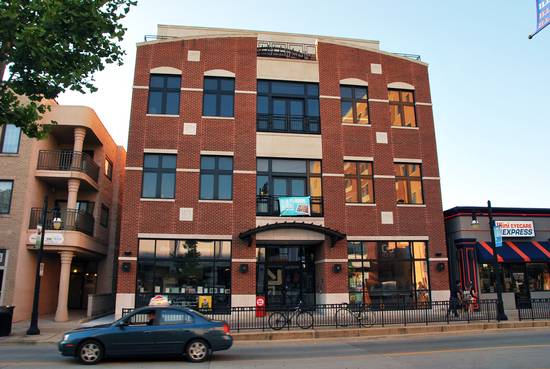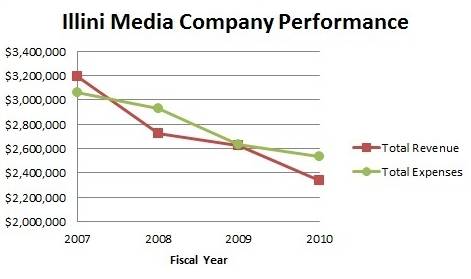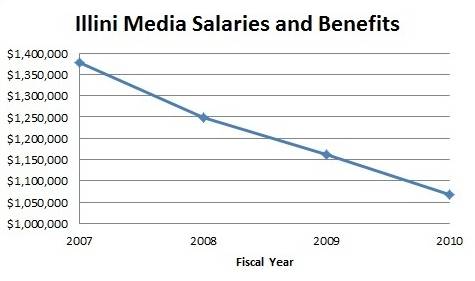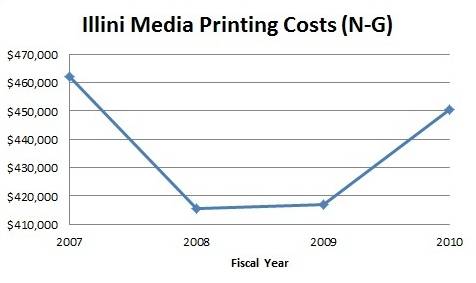
If you’ve been paying much attention at all to the Illini Media Company in the past year, you’ve no doubt noticed that they’ve been making several pleas for assistance. From their website which serves little purpose other than to take donations, to incessant Roger Ebert name-dropping, to the attempt to get a referendum for the proudly independent company to be partially funded by a mandatory student fee, the publisher of the Daily Illini, Buzz, Technograph, and Illio, as well as the broadcaster of WPGU has had its hand out its fair share of the time. This focus on fundraising followed soon after Lilyan Levant replaced longtime publisher Mary Cory, but as you’ll see, the roots of the IMC’s financial issues started long before.
TOUGH TIMES
Illini Media is a federal 501(c)(3), and has been since its corporation, meaning that any contributions made to it are tax-deductible. However, IMC must also file a Form 990, publicly disclosing a summary of its financial information. This information is available online at GuideStar for all U.S. nonprofits for the last three years.
 As you can see in the chart at right, IMC has lost money each of the last three years, finishing fiscal years 2008 to 2010 more than $400,000 in the red, in total.
As you can see in the chart at right, IMC has lost money each of the last three years, finishing fiscal years 2008 to 2010 more than $400,000 in the red, in total.
The company has seen its revenue decline from $3.2 million in fiscal year 2007 (from August 1, 2007 to July 31, 2008) to $2.3 million in fiscal year 2010. Much of this is a product of an industry-wide decline in advertising revenues.
An independent financial audit completed after the 2009 fiscal year concluded that “[c]ertain conditions indicate that the Company may be unable to continue as a going concern.” While citing the $10,714 loss that Illini Media showed that year as an issue, much of this dire assessment was due to a administrative failure regarding the IMC’s $3.5 million bond issue, which paid for the construction of the company’s Green Street headquarters in 2004. From the audit:
The accompanying financial statements have been prepared assuming the Company will continue as a going concern. However, the Company has sustained an operating loss in the current year. In addition, in connection with notes payable to a bank, the Company must comply with debt covenant requirements and, at July 31, 2010, the company failed to meet several of these requirements. The provisions of the loan agreement grant the lender the right to demand immediate repayment of the loan under these circumstances. If the loan is callable and the bank does not waive or subsequently lose its right to demand repayment, the debt must be classified as a current liability, regardless of whether it appears probable or improbable that the lender will actually demand repayment. As of the report date, the bank has not waived its right to demand repayment, and therefore, the statement of financial position shows all of the debt classified as a current liability at July 31, 2010. Considering the current financial position of the Company, there is substantial doubt about its ability to meet this obligation.
Requests for an update to the status of the debt covenant requirements (in addition to requests for comment on numerous other points) were made to Levant, as well as the president and secretary of Illini Media’s board. Smile Politely received no response. Board member and U of I Journalism department head Rich Martin responded, “The board has agreed to let Tom Costello, the board president, and Lil Levant speak for the company. I’m sure they’ll be happy to talk with you.”
In the 2010 audit, it was stated that “during the year the Company signed a promissory note with The News-Gazette, Inc. which had an outstanding balance of $130,391 as of July 31, 2010.” Their creditors also include Hickory Point Bank, which held a $151,555 note in 2010 which was due to be repaid in full by February 2013, and “is collateralized by substantially all assets of the company.”
Illini Media also pays the County of Champaign $22,490 per month for the $3.5 million bond issue. According to the audit, “At any time on or after December 21, 2014 and before January 21, 2015 (with 180 days notice), the bond owner may exercise a ‘put option’ which will require the Company to purchase the bonds.”
ATTEMPTING TO STEM THE TIDE
According to a former employee of Illini Media, “The board has stuck its head in the sand [regarding the financial status of the company]. The people running the company are incompetent and negligent, and they haven’t operated [IMC] like a business, they’ve operated it like a fiefdom.”
 In an attempt to reduce costs, Illini Media has slashed payroll in recent years, as you can see in the chart at left. According to federal filings, IMC had 663 employees in fiscal year 2008, 372 in 2009, and 532 in 2010. These numbers include student employees, of course; the number of full-time positions is much fewer.
In an attempt to reduce costs, Illini Media has slashed payroll in recent years, as you can see in the chart at left. According to federal filings, IMC had 663 employees in fiscal year 2008, 372 in 2009, and 532 in 2010. These numbers include student employees, of course; the number of full-time positions is much fewer.
According to a former WPGU student employee, “The pay for one of the 4–5 managerial positions (under the Program Director, who would get about $250 per month) was $150 (before taxes, turned out ~$135ish after) a month for a job that essentially was a 25–30 (putting it lightly) hour a week position. Oftentimes they pushed the ‘internship’ card onto the student employees, saying that we were lucky to get even that much.
“Before I started working there, ATB (across the board) DJs would get paid monthly for doing shifts all through the week, but that didn’t last long. The only people that got paid when I was there were the managers, and that was slim and typically a battle to get money at all.”
Meanwhile, the former publisher, Mary Cory, made between $92,129 and $96,558 in base salary per year between 2007 and 2010.
LOOKING AHEAD
 In a Daily Illini article entitled “College newspapers moving toward digital future” published June 17, Kyle Milnamow may be foreshadowing when he states, “Some big-named college newspapers and even some professional newspapers have begun to shift their focus from print to more of an online presence.”
In a Daily Illini article entitled “College newspapers moving toward digital future” published June 17, Kyle Milnamow may be foreshadowing when he states, “Some big-named college newspapers and even some professional newspapers have begun to shift their focus from print to more of an online presence.”
As you can see in the chart at right, printing costs paid to the News-Gazette continue to be a significant part of Illini media’s expenditures. As shared in a February DI article, Illini Media owes more than $250,000 to the local newspaper company.
With little apparent irony, February’s DI article also states that, “Unlike most student newspapers and university-affiliated media outlets, the Illini Media Company has been completely financially independent from the University since its inception,” before immediately launching into an announcement that “its newest effort to sustain the company is the proposal of a $3 nonrefundable fee per semester to University students who are taking at least one hour of classes.” This fee would be expected to provide 12% of Illini Media’s operating budget.
IMC’s mission statement reads: “Illini Media is committed to providing an unsurpassed educational opportunity for its student employees and to keeping this mission at the forefront of all our internal decision-making. Our well-run, successful company allows us to offer a professional, hands-on, student-run learning environment, and to provide high-quality communication vehicles for readers, listeners and viewers throughout our campus and community.” It’s a noble cause, and they have their work cut out for them in accomplishing it.
Photo by Sean O’Connor.








